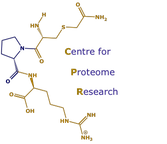Protein sulfation enzymes are targeted by kinase inhibitors
Byrne DP, Li Y1, Ngamlert P, Ramakrishnan K, Eyers CE, Wells C, Drewry DH, Zuercher WJ, Berry NG, Fernig DG, Eyers PA. (2018) New tools for evaluating protein tyrosine sulfation: tyrosylprotein sulfotransferases (TPSTs) are novel targets for RAF protein kinase inhibitors. Biochem J. 475: 2435-2455. doi: 10.1042/BCJ20180266. [PUBMED] [PDF]
Protein tyrosine sulfation is a post-translational modification best known for regulating extracellular protein-protein interactions. Tyrosine sulfation is catalysed by two Golgi-resident enzymes termed tyrosylprotein sulfotransferases (TPSTs) 1 and 2, which transfer sulfate from the cofactor PAPS (3'-phosphoadenosine 5'-phosphosulfate) to a context-dependent tyrosine in a protein substrate. A lack of quantitative tyrosine sulfation assays has hampered the development of chemical biology approaches for the identification of small-molecule inhibitors of tyrosine sulfation. In the present paper, we describe the development of a non-radioactive mobility-based enzymatic assay for TPST1 and TPST2, through which the tyrosine sulfation of synthetic fluorescent peptides can be rapidly quantified. We exploit ligand binding and inhibitor screens to uncover a susceptibility of TPST1 and TPST2 to different classes of small molecules, including the anti-angiogenic compound suramin and the kinase inhibitor rottlerin. By screening the Published Kinase Inhibitor Set, we identified oxindole-based inhibitors of the Ser/Thr kinase RAF (rapidly accelerated fibrosarcoma) as low-micromolar inhibitors of TPST1 and TPST2. Interestingly, unrelated RAF inhibitors, exemplified by the dual BRAF/VEGFR2 inhibitor RAF265, were also TPST inhibitors in vitro We propose that target-validated protein kinase inhibitors could be repurposed, or redesigned, as more-specific TPST inhibitors to help evaluate the sulfotyrosyl proteome. Finally, we speculate that mechanistic inhibition of cellular tyrosine sulfation might be relevant to some of the phenotypes observed in cells exposed to anionic TPST ligands and RAF protein kinase inhibitors.
Protein tyrosine sulfation is a post-translational modification best known for regulating extracellular protein-protein interactions. Tyrosine sulfation is catalysed by two Golgi-resident enzymes termed tyrosylprotein sulfotransferases (TPSTs) 1 and 2, which transfer sulfate from the cofactor PAPS (3'-phosphoadenosine 5'-phosphosulfate) to a context-dependent tyrosine in a protein substrate. A lack of quantitative tyrosine sulfation assays has hampered the development of chemical biology approaches for the identification of small-molecule inhibitors of tyrosine sulfation. In the present paper, we describe the development of a non-radioactive mobility-based enzymatic assay for TPST1 and TPST2, through which the tyrosine sulfation of synthetic fluorescent peptides can be rapidly quantified. We exploit ligand binding and inhibitor screens to uncover a susceptibility of TPST1 and TPST2 to different classes of small molecules, including the anti-angiogenic compound suramin and the kinase inhibitor rottlerin. By screening the Published Kinase Inhibitor Set, we identified oxindole-based inhibitors of the Ser/Thr kinase RAF (rapidly accelerated fibrosarcoma) as low-micromolar inhibitors of TPST1 and TPST2. Interestingly, unrelated RAF inhibitors, exemplified by the dual BRAF/VEGFR2 inhibitor RAF265, were also TPST inhibitors in vitro We propose that target-validated protein kinase inhibitors could be repurposed, or redesigned, as more-specific TPST inhibitors to help evaluate the sulfotyrosyl proteome. Finally, we speculate that mechanistic inhibition of cellular tyrosine sulfation might be relevant to some of the phenotypes observed in cells exposed to anionic TPST ligands and RAF protein kinase inhibitors.
